Common Opossum
- March 19, 2024
- 0 comment
The Common Opossum, scientifically known as Didelphis virginiana, is a fascinating marsupial native to the Americas. With its distinctive appearance and adaptable nature, it has captured the curiosity of many. Typically ranging from 10 to 14 inches in length, with a tail spanning an additional 8 to 13 inches, these creatures are relatively small but can weigh anywhere from 4 to 14 pounds. Their fur varies in color from gray to white, black, or even brown, often with patches of different hues. Opossums are highly adaptable, found in diverse environments ranging from forests and grasslands to urban areas throughout North and South America.
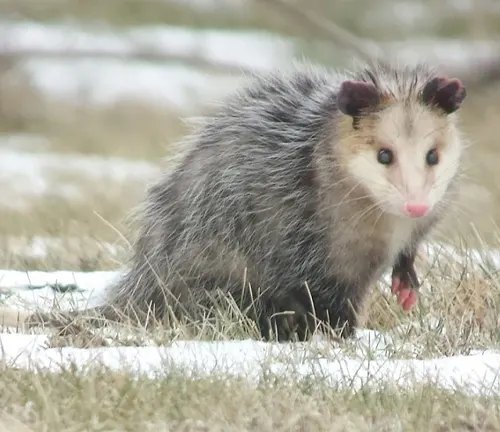
They are omnivorous scavengers, feeding on fruits, insects, small mammals, birds, eggs, and carrion. Known for their nocturnal habits, they are most active during the night, relying on their keen sense of smell and excellent hearing to navigate and find food. One of their most remarkable adaptations is their ability to “play dead” when threatened, a behavior that often deters predators. Despite occasional encounters with humans and misconceptions about their behavior, opossums play a crucial role in maintaining ecosystem balance by controlling pest populations and aiding in the decomposition of organic matter. Overall, these resilient creatures serve as a reminder of the diverse and intriguing wildlife found in the Americas.
| Specification | Description |
|---|---|
| Scientific Name | Didelphis virginiana |
| Common Name | Common Opossum |
| Size | Typically 10 to 14 inches in length, with an additional 8 to 13 inches for the tail |
| Weight | Ranges from 4 to 14 pounds |
| Fur Color | Predominantly gray, with variations including white, black, brown, and silver |
| Habitat | Diverse environments including forests, grasslands, and urban areas |
| Diet | Omnivorous, feeding on fruits, insects, small mammals, birds, eggs, and carrion |
| Activity | Nocturnal, most active during the night |
| Adaptations | Ability to “play dead” when threatened, known as “playing possum” |
| Role in Ecosystem | Control of pest populations, aiding in the decomposition of organic matter |
| Interaction with Humans | Occasional encounters, may be perceived as pests but generally docile |
The Fascinating Creature of the Night
Commonly referred to as the ‘opossum,’ the Common Opossum (Didelphis virginiana) is a marsupial native to the Americas, known for its unique characteristics and adaptability to various environments. From its physical appearance to its behavior and interaction with humans, the common opossum holds an intriguing place in the animal kingdom.
Physical Characteristics
Size and Weight
The Common Opossum typically ranges from 10 to 14 inches in length, with an additional 8 to 13 inches for the tail. While their size may vary slightly depending on factors such as age and sex, they generally fall within this range. In terms of weight, Common Opossums can weigh anywhere from 4 to 14 pounds, with males often being larger than females.
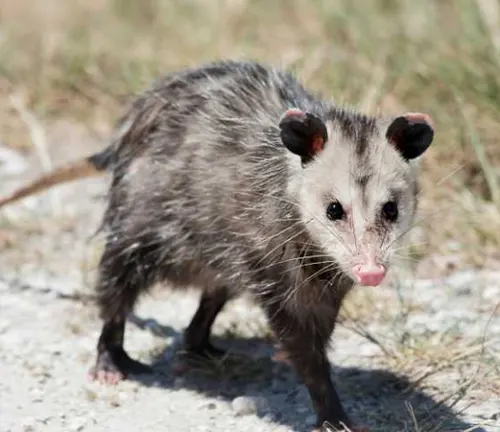
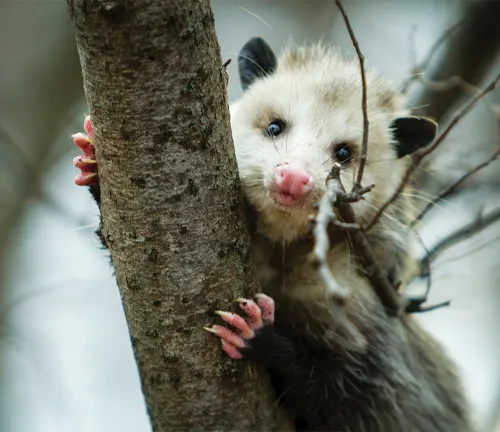
Fur and Coloration
The fur of the Common Opossum is predominantly gray, though variations in color are common. They may exhibit shades of white, black, brown, or silver, often with patches or patterns of different hues. The fur has a coarse texture, providing insulation and protection from the elements. Their coloration serves as camouflage in their natural habitats, helping them blend into various environments ranging from forests to urban areas.
Habitat and Distribution
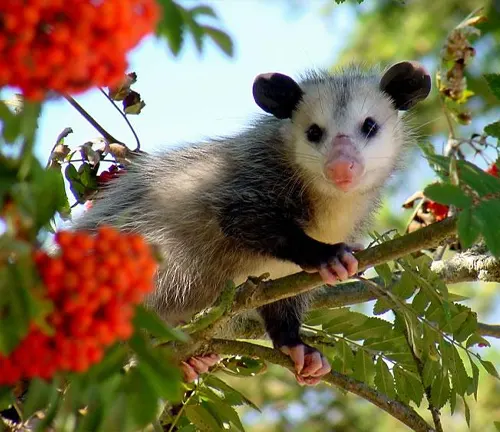
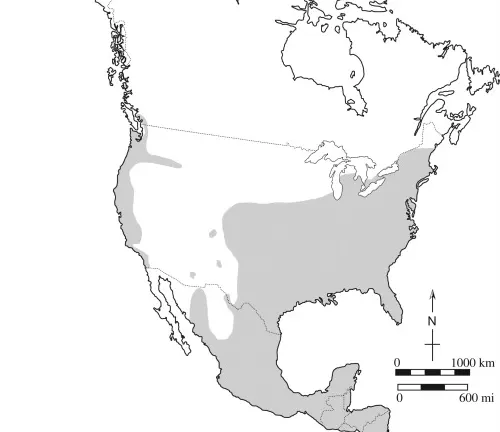
The Common Opossum (Didelphis virginiana) is highly adaptable and can be found inhabiting a diverse range of environments throughout North and South America. From dense forests to open grasslands and even urban areas, opossums have demonstrated their ability to thrive in various habitats. They are commonly found in regions with temperate climates but can also inhabit tropical and subtropical environments.
In terms of distribution, Common Opossums are widespread across the Americas, ranging from southern Canada to northern Argentina. They have established populations in countries such as the United States, Mexico, Brazil, and Venezuela, among others. Their adaptability to different ecosystems has enabled them to colonize a wide geographical range, making them one of the most widely distributed marsupials in the Western Hemisphere.
Within their habitats, opossums seek shelter in a variety of natural and man-made structures, including hollow trees, brush piles, and urban structures like attics and crawl spaces. Their ability to adapt to human-altered landscapes has contributed to their success in colonizing urban and suburban areas, where they may coexist alongside humans.
Diet and Feeding Habits
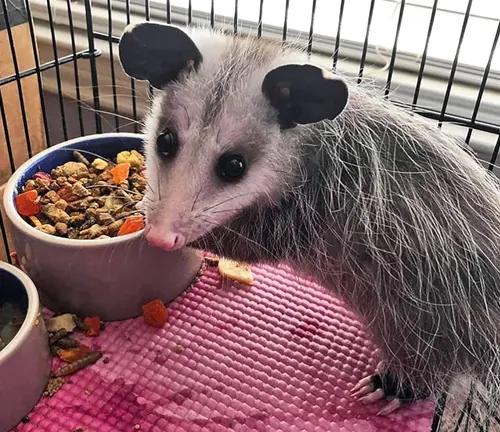
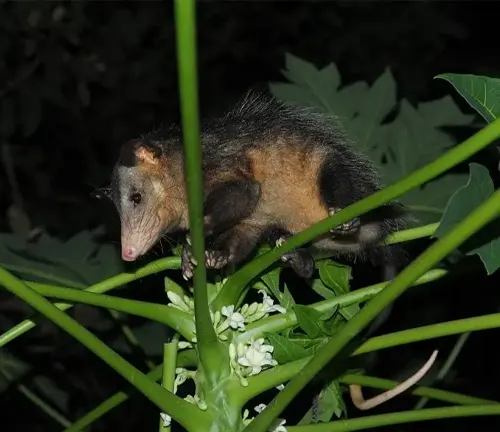
The Common Opossum (Didelphis virginiana) is an omnivorous scavenger with a diverse diet that enables it to adapt to various environments. Their feeding habits are opportunistic, allowing them to consume a wide range of food sources depending on availability.
Opossums primarily feed on fruits, insects, small mammals, birds, eggs, and carrion. They are known to forage for fallen fruits, berries, and nuts in forested areas, while also preying on insects such as beetles, grasshoppers, and spiders. Additionally, they are skilled hunters of small rodents, birds, and reptiles, using their sharp teeth and claws to capture prey.
Their scavenging behavior makes them important contributors to ecosystem health, as they help control pest populations and aid in the decomposition of organic matter. Opossums are known to consume carrion, including roadkill and other carcasses, which helps to clean up and recycle nutrients in the environment.
Behavior and Lifestyle
Nocturnal Nature
The Common Opossum (Didelphis virginiana) is primarily nocturnal, meaning it is most active during the night. This nocturnal behavior is an adaptation that helps opossums avoid predators and take advantage of nighttime opportunities for foraging and hunting. Their keen sense of smell and excellent hearing aid them in navigating their surroundings in low light conditions.

During the day, opossums typically seek shelter in dens or other secluded areas, where they rest and conserve energy. As dusk approaches, they emerge from their shelters to begin their nightly activities. Opossums are well-suited for nocturnal life, with their large eyes providing good low-light vision, and their sensitive whiskers helping them navigate in the dark.
Reproduction and Social Behavior
Opossums are solitary animals for the most part, coming together only during the mating season. Reproduction in opossums is characterized by their unique reproductive anatomy, with females possessing a pouch where they carry and nurse their young, known as joeys.
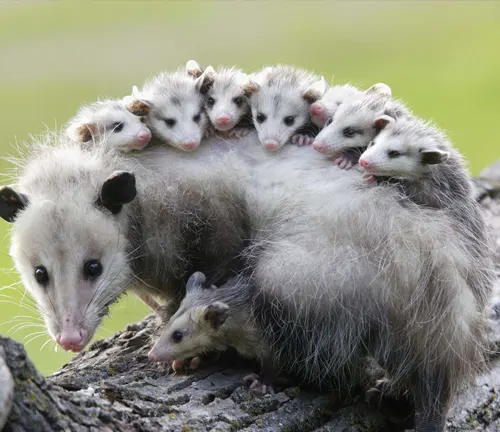
Female opossums give birth to relatively large litters of undeveloped young, which immediately crawl into the pouch to complete their development. The joeys remain in the pouch for several weeks, receiving nourishment from their mother’s milk until they are old enough to venture out on their own.
Once the young opossums leave the pouch, they may continue to stay close to their mother for some time, learning essential survival skills before eventually dispersing to establish their own territories. Male opossums play little to no role in parental care, with females being solely responsible for raising and protecting their offspring.
Adaptations and Survival Strategies
The Common Opossum (Didelphis virginiana) has evolved a range of adaptations and survival strategies that enable it to thrive in diverse environments and overcome various challenges:

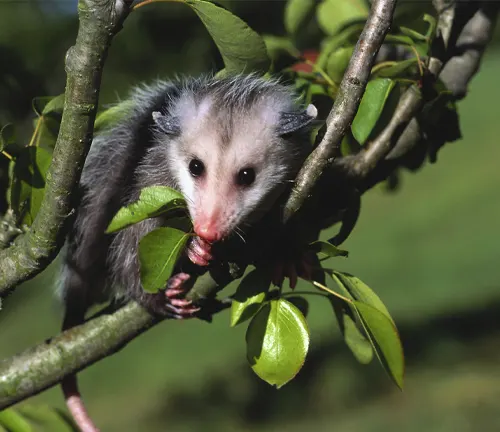
- Playing Dead (Thanatosis): One of the most well-known adaptations of opossums is their ability to “play dead” when threatened by predators—a behavior known as thanatosis. When confronted with danger, opossums may suddenly become immobile, lying on their side with their mouth open, and emit a foul odor resembling that of a decaying animal. This behavior often confuses predators, giving the opossum time to escape.
- Nocturnal Lifestyle: Opossums are primarily nocturnal, meaning they are most active during the night. This adaptation helps them avoid predators and competition for resources, as many of their potential predators are diurnal (active during the day). Their keen senses of smell and hearing aid them in navigating their environment and locating food in the darkness.
- Omnivorous Diet: Opossums have a highly flexible diet and are omnivorous scavengers, capable of consuming a wide variety of food sources. This adaptability allows them to exploit different food resources depending on availability, contributing to their survival in diverse habitats.
- Prehensile Tail: The opossum’s long, prehensile tail serves multiple purposes. It helps them maintain balance when climbing trees or moving through dense vegetation, allowing them to access otherwise inaccessible areas. Additionally, opossums may use their tail to carry nesting materials or grasp objects while foraging.
- Diverse Habitat Use: Opossums are habitat generalists, able to inhabit a wide range of environments, including forests, grasslands, wetlands, and urban areas. This adaptability allows them to colonize new habitats and survive in landscapes altered by human activity.
- Rapid Reproduction: Opossums have relatively short gestation periods and produce large litters of offspring, which enhances their reproductive success. This reproductive strategy enables them to quickly replenish their populations in response to fluctuations in environmental conditions or mortality rates.
- Resistance to Disease: Opossums have developed resistance to many common diseases, including rabies, due to their unique immune system. This resistance helps them survive in environments where disease transmission is prevalent, contributing to their overall survival.
Interaction with Humans
Benefits to Ecosystem
Common Opossums (Didelphis virginiana) play important roles in their ecosystems, contributing to biodiversity and ecosystem health in various ways:
- Control of Pest Populations: Opossums are effective predators of small mammals, insects, and other pests. By feeding on these animals, they help regulate their populations, preventing outbreaks of pest species that could otherwise damage crops or spread disease.
- Seed Dispersal: Opossums consume a variety of fruits and berries as part of their diet. As they move through their environment, they inadvertently disperse seeds through their feces, contributing to the dispersal and germination of plant species.
- Carrion Cleanup: Opossums are scavengers that feed on carrion, including roadkill and other dead animals. By consuming carcasses, they help clean up the environment and recycle nutrients, preventing the spread of disease and reducing foul odors.
- Habitat Modification: Opossums create dens and burrows in their habitats, which can provide shelter for other wildlife species, including small mammals, birds, and reptiles. These structures enhance habitat complexity and provide refuge for a diverse range of organisms.
Nuisance Concerns
While opossums provide important ecological benefits, they can sometimes come into conflict with humans, leading to nuisance concerns:
- Garbage Raiding: Opossums are opportunistic feeders and may rummage through garbage bins in search of food. This behavior can lead to messes and property damage, particularly in urban and suburban areas where human-wildlife interactions are common.
- Garden Damage: Opossums may damage gardens by foraging for fruits, vegetables, and other crops. Their presence can result in losses for gardeners and farmers, particularly if opossums target valuable or delicate plants.
- Pet Interactions: Opossums may encounter domestic pets, such as cats and dogs, leading to potential conflicts or confrontations. While opossums are generally non-aggressive and prefer to avoid confrontation, interactions with pets can result in injuries to both parties.
- Vehicle Collisions: Opossums are vulnerable to vehicle collisions when crossing roads or highways, especially during their nocturnal activities. These collisions can result in injuries or fatalities for opossums and pose risks to motorists.
Common Opossum Myths and Misconceptions
Despite their ecological importance and fascinating behavior, Common Opossums (Didelphis virginiana) are often surrounded by myths and misconceptions. Some of the most common myths include:
- Aggressiveness: One common misconception is that opossums are aggressive animals that pose a threat to humans and pets. In reality, opossums are typically docile and non-aggressive, preferring to flee rather than confront a threat.
- Disease Carriers: Another myth is that opossums are carriers of diseases such as rabies and transmit them to humans and pets. While opossums can carry certain diseases, instances of disease transmission to humans are rare, and they are actually resistant to many common diseases, including rabies.
- Destructive Behavior: Opossums are sometimes perceived as destructive animals that cause damage to property and gardens. While they may occasionally forage for food in garbage bins or gardens, their impact is generally minimal and can be mitigated through simple measures.
- Low Intelligence: Some people mistakenly believe that opossums are unintelligent animals due to their unusual appearance and behavior. In reality, opossums are highly adaptable and resourceful creatures with complex behaviors and cognitive abilities.
Conservation Status
The Common Opossum is not currently listed as a threatened species, and populations are generally stable throughout its range. However, habitat loss, human activities, and other factors pose potential threats to opossum populations in certain areas.
Human Impact and Threats
Several human activities and factors can impact opossum populations and pose threats to their survival:
- Habitat Loss: Deforestation, urbanization, and habitat fragmentation are major threats to opossum populations, reducing available habitat and limiting their ability to find suitable food and shelter.
- Vehicle Collisions: Opossums are frequently killed or injured in vehicle collisions, especially in areas where roads intersect with their habitats. Road mortality can have significant impacts on local opossum populations.
- Pollution: Pollution from industrial and agricultural activities can contaminate opossum habitats and food sources, leading to health issues and reproductive problems.
- Persecution: Opossums may be persecuted by humans due to misconceptions about their behavior or perceived nuisance concerns. Trapping, poisoning, and other forms of lethal control can negatively impact opossum populations and disrupt ecosystem dynamics.
Management and Conservation Efforts
Efforts to manage and conserve opossum populations may include:
- Habitat Protection: Protecting and preserving opossum habitat through land conservation efforts, habitat restoration, and sustainable land management practices.
- Public Education: Educating the public about the ecological importance of opossums, dispelling myths and misconceptions, and promoting coexistence with wildlife.
- Wildlife Rehabilitation: Establishing wildlife rehabilitation centers to rescue, rehabilitate, and release injured or orphaned opossums back into the wild.
- Mitigation Measures: Implementing measures to reduce human-wildlife conflicts, such as installing wildlife-friendly fencing, securing garbage bins, and providing alternative food sources for opossums.
Fascinating Facts about Common Opossum
- Opossums have a remarkably short lifespan, with most individuals living only about two to four years in the wild.
- They have a unique immune system that makes them resistant to many diseases, including rabies.
- Despite their somewhat intimidating appearance, opossums are generally docile creatures and will usually retreat rather than confront a threat.
Different Species
Southern Opossum
(Didelphis marsupialis)
Found in Central and South America, this species is similar in appearance to the Common Opossum but has a more limited range.
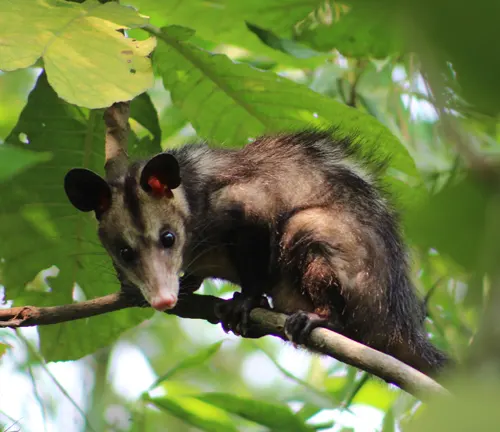
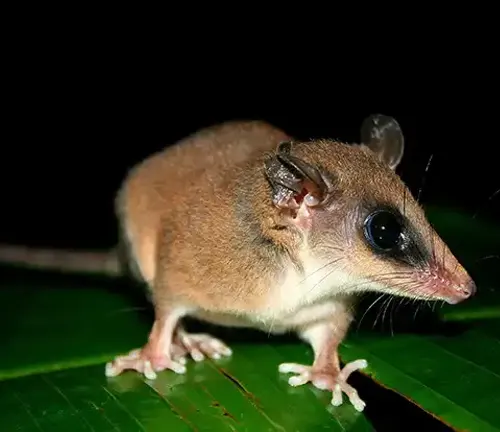
Mexican Opossum
(Didelphis mexicana)
Endemic to Mexico, this species has a smaller range compared to the Common Opossum and is typically found in forested areas.
White-eared Opossum
(Didelphis albiventris)
Native to South America, this species is characterized by its distinctive white ears and inhabits a variety of habitats, including forests and grasslands.
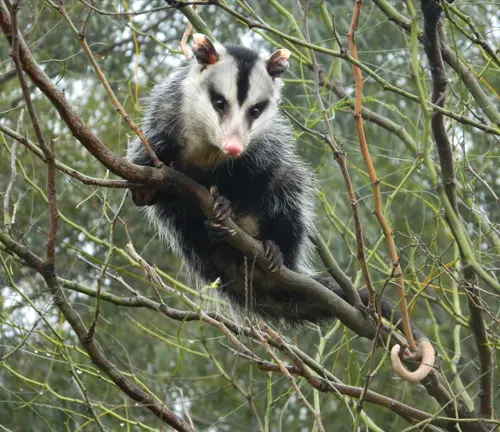
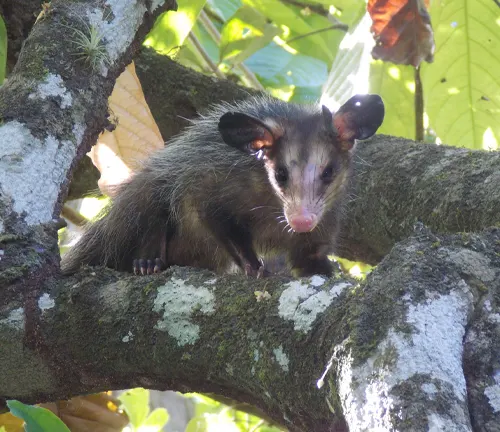
Big-eared Opossum
(Didelphis aurita)
Found in Brazil, Paraguay, and Argentina, this species has large, prominent ears and is adapted to living in dense vegetation.
Frequently Asked Questions (FAQs)
- Are opossums dangerous to humans?
Opossums are generally not dangerous to humans. They are shy and non-aggressive creatures that prefer to avoid confrontation. They are more likely to flee than to attack if they feel threatened. - Do opossums carry diseases?
While opossums can carry diseases like leptospirosis and tuberculosis, they are resistant to many common diseases, including rabies. Instances of disease transmission from opossums to humans are rare. - What should I do if I encounter an injured opossum?
If you come across an injured or orphaned opossum, it’s best to contact a local wildlife rehabilitation center for assistance. Attempting to handle them yourself can result in further injury to the animal or yourself. - How can I deter opossums from entering my property?
To discourage opossums from rummaging through garbage or causing disturbances, ensure that garbage bins are securely closed and remove any potential food sources from your yard, such as fallen fruits or pet food left outside. - Are opossums beneficial to the environment?
Yes, opossums play a vital role in ecosystems by controlling insect populations, aiding in the decomposition of organic matter, and serving as prey for larger predators. They contribute to maintaining ecological balance. - What do opossums eat?
Opossums are omnivores and eat a wide variety of foods, including fruits, insects, small mammals, birds, eggs, and carrion. Their diet is diverse and adaptable to their surroundings. - Do opossums carry their young in a pouch?
Yes, female opossums have a pouch where they carry and nurse their young, known as joeys. The pouch provides protection and support for the developing offspring until they are old enough to venture out on their own. - How long do opossums live?
In the wild, opossums typically live for about two to four years. However, in captivity or under favorable conditions, they may live longer. - What predators do opossums have?
Opossums have several natural predators, including owls, hawks, coyotes, foxes, and domestic dogs. Their nocturnal behavior and ability to “play dead” serve as defense mechanisms against predators. - Do opossums hibernate?
Opossums do not hibernate in the traditional sense. However, they may become less active during periods of extreme cold or scarcity of food, entering a state of torpor to conserve energy. - Can opossums climb trees?
Yes, opossums are adept climbers and are capable of climbing trees using their sharp claws and prehensile tails. They often seek refuge in trees to escape predators or find food.


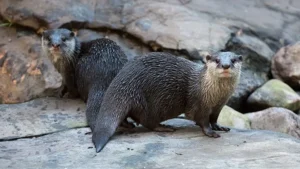
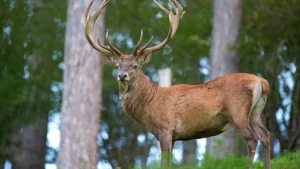

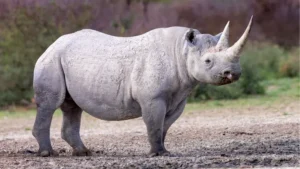
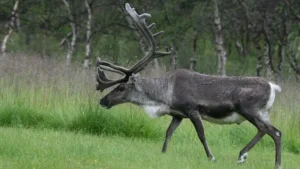
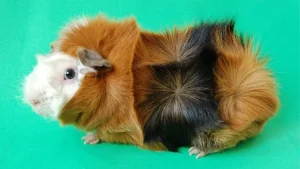


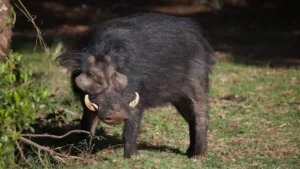
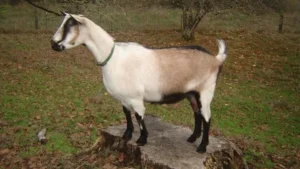
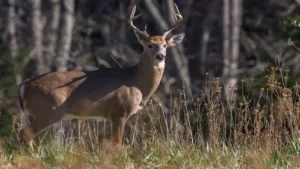

Leave your comment